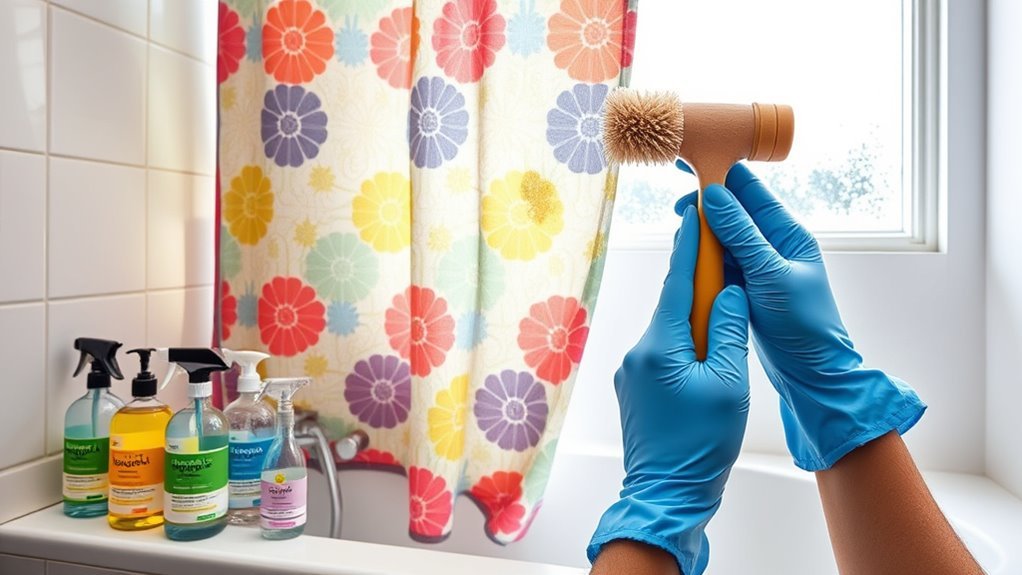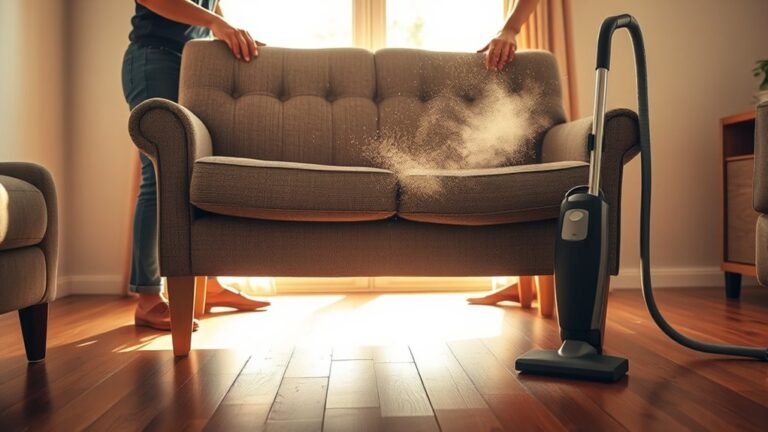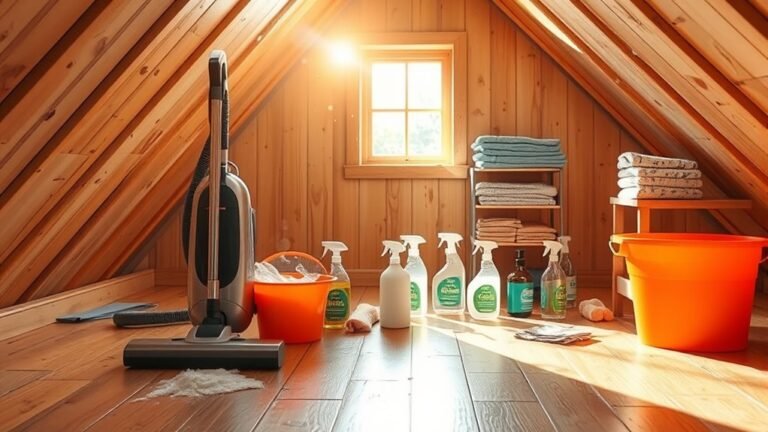Tackling Mildew on Shower Curtains
You can tackle mildew on your shower curtain by keeping your bathroom well-ventilated and drying the curtain fully after each use. Look for small discolored spots early and clean them using a vinegar-and-water spray, scrubbing gently before rinsing. Avoid harsh chemicals and let the curtain air dry completely. Regular cleaning and proper drying can prevent mildew from returning. If you want to know how to keep your shower curtain fresh longer and stop mildew before it starts, keep exploring these tips.
Understanding the Causes of Mildew on Shower Curtains

Although it might seem harmless, the constant moisture and warmth in your bathroom create the perfect environment for mildew to grow on your shower curtain. When moisture levels stay high without proper ventilation, mildew growth becomes inevitable. You want to enjoy your space without feeling trapped by stubborn stains or unpleasant odors. Understanding that mildew thrives in damp, warm conditions helps you see why your shower curtain is vulnerable. It’s not just about dirt; it’s about creating conditions where mildew can flourish. By recognizing how moisture levels influence mildew growth, you gain the power to change your bathroom’s environment. This freedom to control your space means less mildew and a cleaner shower curtain, letting you embrace a fresh, open atmosphere every day.
Identifying Mildew Early for Effective Treatment
If you catch mildew on your shower curtain early, treating it becomes much easier and more effective. You don’t have to wait until stubborn black spots spread across the fabric. Early detection is all about making visual inspection a habit—take a quick look at your curtain every few days. Focus on the folds and bottom edges where moisture lingers and mildew loves to hide. Spotting tiny, discolored patches or a musty smell early on gives you the freedom to act fast and prevent a bigger problem. By staying vigilant, you’ll keep your shower curtain fresh without hassle. Embrace this simple routine, and you’ll avoid mildew’s grip, enjoying a cleaner, fresher bathroom with minimal effort.
Choosing the Right Cleaning Supplies

When it comes to tackling mildew on your shower curtain, choosing the right cleaning supplies can make all the difference. You want products that effectively remove mildew while respecting your health and the environment. Look for eco friendly options that avoid harsh chemicals, giving you peace of mind about chemical safety. Natural ingredients like vinegar, baking soda, or plant-based cleaners work well without releasing toxic fumes. Avoid bleach or ammonia, which can irritate your skin and lungs. Choosing the right supplies means you’re not just cleaning—you’re reclaiming your space without compromising your freedom to breathe easy. By selecting safe, sustainable products, you control how you care for your home, keeping mildew at bay while honoring your values and well-being.
Step-By-Step Guide to Cleaning Mildew From Shower Curtains
First, you’ll want to spot all the mildew spots clearly to target them effectively. Then, using the right cleaning solutions will help you remove the mildew without damaging your curtain. Finally, adopting some simple habits can prevent mildew from coming back in the future.
Identifying Mildew Spots
Spotting mildew on your shower curtain is easier than you might think once you know what to look for. Start with a thorough shower curtain inspection, focusing on damp areas and folds where mildew loves to hide. Mildew often appears as small, dark spots—usually black, gray, or greenish. Using simple mildew identification techniques, you can distinguish these spots from soap scum or dirt by their fuzzy or powdery texture. Pay close attention to the bottom edge and corners, as they’re the most vulnerable. If you notice a musty smell or discoloration, that’s another clear sign. By regularly inspecting your curtain, you’ll catch mildew early, making it easier to address and keep your shower space fresh and clean.
Effective Cleaning Solutions
Although mildew can be stubborn, you can remove it effectively with the right cleaning solutions and techniques. To free your shower curtain from mildew, focus on mildew removal with common household items. Keep your cleaning frequency consistent to prevent buildup and maintain a fresh space.
Try these steps for a thorough clean:
- Mix equal parts white vinegar and water in a spray bottle, then spray the curtain.
- Let it sit for 10-15 minutes to break down mildew.
- Scrub gently with a soft brush or cloth.
- Rinse thoroughly and air dry completely.
Stick to this routine regularly, and you’ll enjoy a mildew-free shower curtain that feels liberating, not limiting.
Preventing Future Mildew
Since mildew thrives in damp, humid environments, preventing it on your shower curtain means keeping the area as dry and well-ventilated as possible. Start by choosing shower curtains made from mildew resistant materials—they’re designed to repel moisture and resist fungal growth, giving you a hassle-free experience. Next, focus on bathroom humidity control: use exhaust fans during and after showers to reduce moisture buildup, or open a window if possible. After each shower, spread the curtain wide to let it air dry fully instead of leaving it bunched up. Regularly wash your curtain following care instructions to maintain its mildew resistance. By combining these simple steps, you’ll free yourself from constant mildew battles and enjoy a fresher, cleaner bathroom environment.
Natural Remedies for Removing Mildew
When mildew starts to form on your shower curtains, you don’t have to rely on harsh chemicals to get rid of it. You can embrace natural remedies that are effective and gentle. Try these simple methods to reclaim your freedom from mildew:
- Sprinkle baking soda on the curtain, then scrub gently with a damp cloth to lift mildew stains.
- Spray a vinegar solution (equal parts white vinegar and water) directly onto affected areas, let it sit for 10 minutes, then rinse.
- Mix lemon juice with salt to create a paste; apply to mildew spots and let it dry before rinsing.
- Hang your curtain in sunlight after treatment to naturally kill lingering spores.
These natural solutions offer powerful, eco-friendly ways to refresh your shower curtain without toxic residue.
Preventative Measures to Keep Mildew at Bay

To keep mildew from coming back, you’ll want to focus on proper ventilation and a regular cleaning routine. Making sure your bathroom stays dry and aired out can make a big difference. Consistently wiping down your shower curtain will help stop mildew before it starts.
Proper Ventilation Techniques
Although mildew thrives in damp environments, you can greatly reduce its growth by ensuring your bathroom is well-ventilated. Proper ventilation is key to controlling humidity and boosting air circulation, keeping your shower curtain fresh and mildew-free. Here’s how you can take charge:
- Open windows during and after showers to let moisture escape.
- Use an exhaust fan or install one if your bathroom lacks it.
- Keep the bathroom door slightly open to encourage airflow.
- Consider a dehumidifier for persistent humidity problems.
Regular Cleaning Routine
Keeping your bathroom well-ventilated helps, but it won’t stop mildew completely if you don’t clean regularly. To truly keep mildew at bay, you need a smart regular cleaning routine. Pay attention to your cleaning frequency—aim for washing your shower curtain every two to three weeks. This prevents mildew from gaining a foothold and keeps your space fresh without feeling like a chore. When it comes to detergent selection, choose a mildew-fighting formula or one with natural antifungal ingredients. Avoid harsh chemicals that can damage your curtain or irritate your skin. By sticking to this routine, you free yourself from constant mildew worries and enjoy a cleaner, healthier bathroom environment. It’s about making mildew prevention simple and effective, so you can focus on living freely.
How to Properly Dry and Store Shower Curtains
Once you’ve cleaned your shower curtain, you’ll want to dry it thoroughly to prevent mildew from returning. Proper drying techniques are key to keeping your curtain fresh and mold-free. Here’s how you can do it with ease and freedom:
Dry your shower curtain thoroughly to prevent mildew and keep it fresh and mold-free.
- Hang your curtain fully extended on the rod to air dry naturally.
- Avoid folding or bunching up the curtain, as trapped moisture invites mildew.
- Use a fan or open a window to speed up drying with better airflow.
- For vinyl or plastic curtains, wipe down with a dry towel to remove excess water.
When it comes to storage solutions, make sure your curtain is completely dry before folding and storing it in a cool, dry place. This simple care keeps mildew at bay and lets you enjoy a clean, fresh shower experience every time.
When to Replace Your Shower Curtain
Knowing when to replace your shower curtain is essential to maintaining a clean and healthy bathroom environment. Over time, mildew and wear can reduce its effectiveness and appearance. Keep an eye out for clear replacement signs and consider the curtain lifespan, usually 6-12 months for fabric and 1-2 years for vinyl.
| Replacement Signs | Curtain Lifespan |
|---|---|
| Persistent mildew spots | Fabric: 6-12 months |
| Tears or holes | Vinyl: 1-2 years |
| Faded colors | Frequent use shortens lifespan |
| Stiff or brittle texture | Regular cleaning extends lifespan |
| Musty odor | Replace immediately if odor persists |
Tips for Maintaining a Mold-Free Bathroom Environment
Although bathrooms are naturally humid, you can prevent mold growth by managing moisture effectively. Keeping bathroom humidity low is key to stopping mildew growth on your shower curtain and other surfaces. Here’s how you can maintain a mold-free bathroom environment without feeling restricted:
- Use an exhaust fan or open a window during and after showers to vent out moisture.
- Wipe down wet surfaces like the shower walls and curtain regularly to remove excess water.
- Wash your shower curtain frequently with mold-fighting detergents or vinegar to keep mildew at bay.
- Keep bathroom items like towels and rugs dry by hanging them properly and replacing damp ones promptly.
Frequently Asked Questions
Can Mildew on Shower Curtains Cause Health Problems?
Yes, mildew exposure can cause health problems, especially if you’re sensitive or have asthma. When you breathe in mildew spores, it can trigger respiratory issues like coughing, wheezing, or shortness of breath. You don’t want that to limit your freedom to enjoy your space comfortably. Keeping your shower curtains clean helps you avoid these risks and breathe easier, letting you live freely without worrying about hidden health hazards.
Are There Specific Shower Curtain Materials That Resist Mildew Better?
You might be surprised to learn that some shower curtain materials naturally fight mildew better than others. Fabrics like polyester and vinyl are known mildew resistant materials, keeping your bathroom fresher longer. But that’s not all—you’ll want to combine the right curtain with smart curtain maintenance tips, like regular washing and drying, to truly keep mildew at bay. With these choices, you’ll enjoy a cleaner, freer shower experience every day.
How Often Should Shower Curtains Be Washed to Prevent Mildew?
You should aim to wash your shower curtains every two to three weeks to keep mildew at bay. Regular shower maintenance like this helps prevent buildup and keeps your bathroom feeling fresh. If you want more freedom from constant cleaning, consider quick daily rinses or using mildew-resistant liners. Adjust the cleaning frequency based on how often you shower and your bathroom’s humidity. Staying consistent means less hassle and a cleaner space without much effort.
Is Bleach Safe to Use on All Types of Shower Curtains?
Bleach might seem like a quick fix, but it’s not safe for all shower curtains—especially fabric ones, which can fade or weaken. You want your shower curtain care to be effective yet gentle, right? Instead, try bleach alternatives like vinegar or baking soda; they’re free, natural, and less harsh. This way, you keep your curtain fresh without sacrificing its lifespan or your freedom to choose eco-friendly options.
Can Mildew Spread From Shower Curtains to Other Bathroom Surfaces?
Yes, mildew can spread from your shower curtains to other bathroom surfaces if you’re not careful. To keep your space fresh and clean, focus on mildew prevention by regularly cleaning and drying surfaces. Maintaining good bathroom hygiene helps stop spores from traveling and taking hold elsewhere. By staying on top of moisture and ventilation, you’ll enjoy a healthier, mildew-free bathroom without feeling confined by constant cleaning chores.






